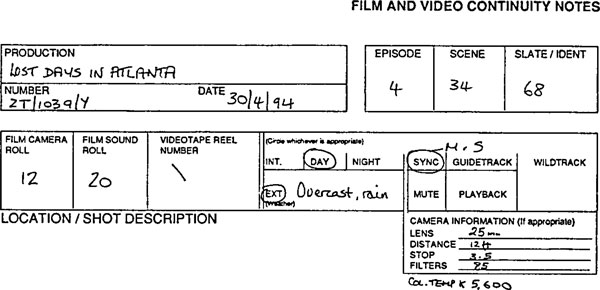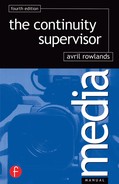Continuity Report Sheet: Camera Information
This information is sometimes given to you to write down when shooting on film and on single-camera video – especially when it is a drama shoot.
The information, when given, will serve an important function for the technical continuity of shot size, aperture, colour temperature and filters used during a shooting sequence, especially with drama, when retakes or additional shots might be necessary and taken at a later time.
The information you may be required to write down refers specifically to the lens – both with film and video. A film camera will be equipped with a series of fixed focal length lenses – referred to as prime lenses – and a zoom lens, which usually includes most of the angles covered by the prime lenses. Additional lenses, such as a telephoto or narrow angle/long lens or a wide angle lens might be needed for specific shots.
A video camera will be equipped with two zoom lenses – a standard zoom lens and a wide angle zoom lens. Prime lenses for single-camera shooting are also available.
For continuity of a shot size, you will be asked to write down the lens angle and lens distance of the shot. The lens angle is the angle of view of the subject as ‘seen’ by the lens and this information is of no use without the ‘lens-to-subject’ distance being written down as well in order to match shot sizes.
For continuity of exposure, you will be asked to write down the lens stop. The stop relates to the amount of light allowed through the lens to expose the film or videotape. On particular occasions the camera operator will deliberately ‘under-expose’ the shot, i.e. make it darker, and will need to be reminded at a later date of the extent of under-exposure to enable exposure continuity. With film, the stop – or lens aperture – is measured using a light meter, and with video, this is measured by the lens itself.
For continuity of colour of shot, you will need to write down the colour correction filter used for film, or the colour temperature for video. When using film, which can be balanced to artificial light or daylight, a colour correction filter is used to convert the colour of the light being used to the colour for which the film has been pre-set. Tungsten film is balanced for artificial fight. Daylight film is balanced for daylight. Sometimes tungsten film is used in daylight and daylight film in artificial light. In order to do this, the camera operator uses colour correction filters – an orange ‘85’ when shooting daylight scenes on tungsten film.
These filters are not necessary when shooting on video, as the camera is able to balance for any colour of light. But to match colours in a shooting sequence you may be asked to write down the colour temperature of the light used. Artificial light would normally be about 3500 K, and daylight about 5600 K. The symbol K denotes the colour temperature in degrees Kelvin.
For continuity of effect, the DOP or lighting camera operator has, at his disposal, in addition to correction filters, a vast array of other filters to create mood and style. Obviously the exact combination must be noted, both to match shots and for retakes.


